Atmospheric sciences
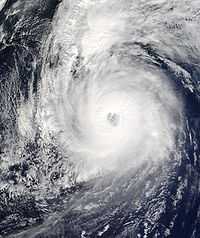
"Atmospheric sciences is an umbrella term for the study of the [Earth's and other objects, sources, or entities] atmosphere, its processes, the effects other systems have on the atmosphere, and the effects of the atmosphere on these other systems."[1]
Sciences
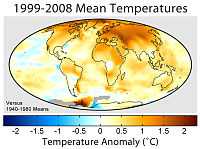
Def. the disciplines or branches of learning, especially those "dealing with measurable or systematic principles ... the collective [disciplines] of study or learning acquired through the scientific method"[2] are called the sciences.
Def. in the definite "[a] method of discovering knowledge about the natural world based in making falsifiable predictions (hypotheses), testing them empirically, & developing theories that match known data from repeatable physical experimentation"[3] is called the scientific method.
Climatology "is the study of climate, scientifically defined as weather conditions averaged over a period of time,[4] and is a branch of the atmospheric sciences."[5]
"Climate encompasses the statistics of temperature, humidity, atmospheric pressure, wind, rainfall, atmospheric particle count and numerous other meteorological elements in a given region over long periods of time."[6]
Atmospheres
Def. "[t]he gases surrounding the Earth or any astronomical body"[7] are called an atmosphere.
Theoretical atmospheric sciences
Def. the invisible gaseous substance "above the surface of the earth"[8] is called air.
Def. "[t]he air in a particular place"[7] is called an atmosphere.
Meteors
Def. "[t]he study of the atmosphere and its phenomena, especially with weather and weather forecasting"[9] is called meteorology.
Atmochemistry

The emissions of biogenic volatile organic compounds (BVOC) are relevant to atmospheric particle dynamics.[10]
X-rays

At right is an X-ray image of Mars. X-radiation from the Sun excites oxygen atoms in the Martian upper atmosphere, about 120 km above its surface, to emit X-ray fluorescence. A faint X-ray halo that extends out to 7,000 km above the surface of Mars has also been found.[11] The Chandra X-ray Observatory image on the lower right is the first look at X-rays from Mars.
Visuals
Def. "[t]he observation of the atmosphere"[12] is called aerology.
Ions

Def. "the atmosphere of the Earth and the other planets with reference to their chemical composition, physical properties, relative motion, and responses to radiation from space"[13] is called aeronomy.
"Aeronomy is the study of the upper layers of the atmosphere, where dissociation and ionization are important."[1]
"Aeronomy is the science of the upper region of the atmosphere, where dissociation and ionization are important.[14]"[15]
Compounds
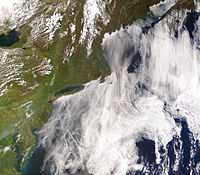
On the right is a satellite image of ship tracks, clouds created by the exhaust of ship smokestacks.
Mars
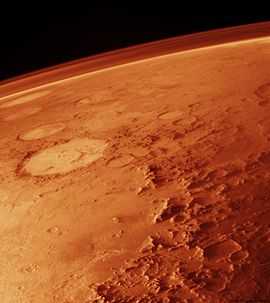
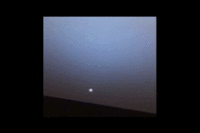
At right is a view of the Martian atmosphere and surface taken through the Viking Orbiter violet filter to illustrate the dramatic clarity "of the atmosphere in the region east and northeast of the Argyre basin during winter in the southern hemisphere. [The image is] taken just after the winter solstice when solar heating is minimal."[16]
"On Sol 20 of its journey, Mars Exploration Rover Opportunity woke up around 5:30 in the martian afternoon to watch the sunset. A series of five sets of three-color images [on the lower right] from the rover's panoramic camera was acquired looking toward the southwest. Each set used an infrared, green and violet filter, rather than the human red-green-blue, so that the maximum panoramic camera wavelength range could be covered by the observations, enhancing the scientific value of the measurements."[17]
"A color image was made [at lower right] from the first post-sunset sequence of calibrated color images, with the color balance set to approximate what the sunset color would have looked like to the human eye. The color seen in this first post-sunset image was then used to colorize each image in the sequence. Approximately one-minute gaps between consecutive color images meant the Sun's position changed within each color set, so the images had to be manually shifted to compensate for this motion. In this fashion, the position and brightness of the Sun are taken from each individual image, but the color is taken from a single set of images. The images were then combined into a movie where one color set fades gracefully into the next. Analysis of the five color sets shows that there were only small color variations during the sunset, so most of the real variations are captured in the movie."[17]
"The rapid dimming of the Sun near the horizon is due to the dust in the sky. There is nearly twice as much dust as there was when the Mars Pathfinder spacecraft, which landed on Mars in 1997, imaged the sunset. This causes the Sun to be many times fainter. The sky above the Sun has the same blue tint observed by Pathfinder and also by Viking, which landed on Mars in 1976. This is because dust in the martian atmosphere scatters blue light forward toward the observer much more efficiently than it scatters red light forward. Therefore, a "halo" of blueish sky color is always observed close to the Sun. We're only seeing half of this halo in the movie, because the other half is below the horizon."[17]
Research
Hypothesis:
- Atmospheres such as on Earth may be governed more by the natural electric field of the Earth than by convection kinetics.
Control groups

The findings demonstrate a statistically systematic change from the status quo or the control group.
“In the design of experiments, treatments [or special properties or characteristics] are applied to [or observed in] experimental units in the treatment group(s).[18] In comparative experiments, members of the complementary group, the control group, receive either no treatment or a standard treatment.[19]"[20]
Proof of concept
Def. a “short and/or incomplete realization of a certain method or idea to demonstrate its feasibility"[21] is called a proof of concept.
Def. evidence that demonstrates that a concept is possible is called proof of concept.
The proof-of-concept structure consists of
- background,
- procedures,
- findings, and
- interpretation.[22]
See also
References
- 1 2 "Atmospheric sciences, In: Wikipedia". San Francisco, California: Wikimedia Foundation, Inc. April 23, 2012. Retrieved 2012-05-22.
- ↑ "science, In: Wiktionary". San Francisco, California: Wikimedia Foundation, Inc. February 15, 2013. Retrieved 2013-02-19.
- ↑ "scientific method, In: Wiktionary". San Francisco, California: Wikimedia Foundation, Inc. December 27, 2012. Retrieved 2013-02-19.
- ↑ "Climate Prediction Center Climate Glossary". Retrieved November 23, 2006.
- ↑ "Climatology, In: Wikipedia". San Francisco, California: Wikimedia Foundation, Inc. May 17, 2012. Retrieved 2012-05-22.
- ↑ "Natural environment, In: Wikipedia". San Francisco, California: Wikimedia Foundation, Inc. February 20, 2013. Retrieved 2013-02-21.
- 1 2 "atmosphere, In: Wiktionary". San Francisco, California: Wikimedia Foundation, Inc. February 21, 2013. Retrieved 2013-02-21.
- ↑ "air, In: Wiktionary". San Francisco, California: Wikimedia Foundation, Inc. February 10, 2013. Retrieved 2013-02-22.
- ↑ "meteorology, In: Wiktionary". San Francisco, California: Wikimedia Foundation, Inc. February 16, 2013. Retrieved 2013-02-21.
- ↑ R. Steinbrecher, B. Rappenglück, A. Hansel, M. Graus, O. Klemm, A. Held, A. Wiedensohler, and A. Nowak (2004). Egbert Matzner. ed. The Emissions of Biogenic Volatile Organic Compounds (BVOC) and Their Relevance to Atmospheric Particle Dynamics, In: Biogeochemistry of Forested Catchments in a Changing Environment A German Case Study. Berlin: Springer-Verlag. pp. 215-32. ISBN 3-540-20973-5. http://books.google.com/books?id=9AWCt2ULM4QC&printsec=frontcover&hl=en. Retrieved 2012-02-22.
- ↑ K. Dennerl (November 2002). "Discovery of X-rays from Mars with Chandra". Astronomy & Astrophysics 394 (11): 1119-28. doi:10.1051/0004-6361:20021116.
- ↑ "aerology, In: Wiktionary". San Francisco, California: Wikimedia Foundation, Inc. October 16, 2012. Retrieved 2013-02-22.
- ↑ "aeronomy, In: Wiktionary". San Francisco, California: Wikimedia Foundation, Inc. March 26, 2012. Retrieved 2013-02-22.
- ↑ Sydney Chapman (1960). The Thermosphere - the Earth's Outermost Atmosphere. Physics of the Upper Atmosphere. Academic Press. pp. 4. ISBN 978-0125820509.
- ↑ "Aeronomy, In: Wikipedia". San Francisco, California: Wikimedia Foundation, Inc. May 6, 2012. Retrieved 2012-05-22.
- ↑ M.H. Carr, W.A. Baum, K.R. Blasius, G.A. Briggs, J.A. Cutts, T.C. Duxbury, R. Greeley, J. Guest, H. Masursky, B.A. Smith, L.A. Soderblom, J. Veverka, J.B. Wellman (May 9, 1980). "NASA SP-441: VIKING ORBITER VIEWS OF MARS". Washington, DC USA: NASA. Retrieved 2013-04-01.
- 1 2 3 Sue Lavoie (February 26, 2004). "PIA05343: The Sun Sets on Mars". Pasadena, California USA: NASA/JPL. Retrieved 2013-04-01.
- ↑ Klaus Hinkelmann, Oscar Kempthorne (2008). Design and Analysis of Experiments, Volume I: Introduction to Experimental Design (2nd ed.). Wiley. ISBN 978-0-471-72756-9. http://books.google.com/?id=T3wWj2kVYZgC&printsec=frontcover.
- ↑ R. A. Bailey (2008). Design of comparative experiments. Cambridge University Press. ISBN 978-0-521-68357-9. http://www.cambridge.org/uk/catalogue/catalogue.asp?isbn=9780521683579.
- ↑ "Treatment and control groups, In: Wikipedia". San Francisco, California: Wikimedia Foundation, Inc. May 18, 2012. Retrieved 2012-05-31.
- ↑ "proof of concept, In: Wiktionary". San Francisco, California: Wikimedia Foundation, Inc. November 10, 2012. Retrieved 2013-01-13.
- ↑ Ginger Lehrman and Ian B Hogue, Sarah Palmer, Cheryl Jennings, Celsa A Spina, Ann Wiegand, Alan L Landay, Robert W Coombs, Douglas D Richman, John W Mellors, John M Coffin, Ronald J Bosch, David M Margolis (August 13, 2005). "Depletion of latent HIV-1 infection in vivo: a proof-of-concept study". Lancet 366 (9485): 549-55. doi:10.1016/S0140-6736(05)67098-5. http://www.ncbi.nlm.nih.gov/pmc/articles/PMC1894952/. Retrieved 2012-05-09.
External links
- African Journals Online
- Bing Advanced search
- Google Books
- Google scholar Advanced Scholar Search
- International Astronomical Union
- JSTOR
- Lycos search
- NASA/IPAC Extragalactic Database - NED
- NASA's National Space Science Data Center
- NCBI All Databases Search
- NCBI Site Search
- Office of Scientific & Technical Information
- PubChem Public Chemical Database
- Questia - The Online Library of Books and Journals
- SAGE journals online
- The SAO/NASA Astrophysics Data System
- Scirus for scientific information only advanced search
- SDSS Quick Look tool: SkyServer
- SIMBAD Astronomical Database
- SIMBAD Web interface, Harvard alternate
- Spacecraft Query at NASA.
- SpringerLink
- Taylor & Francis Online
- WikiDoc The Living Textbook of Medicine
- Wiley Online Library Advanced Search
- Yahoo Advanced Web Search
| |||||||||||||||||||||||||||||||||||
| ||||||||||||||||||||||||||||||||||||||||||||
| |||||||||||||||||||||||||||||||||||
![]() This is a research project at http://en.wikiversity.org
This is a research project at http://en.wikiversity.org
| |
Development status: this resource is experimental in nature. |
| |
Educational level: this is a research resource. |
| |
Resource type: this resource is an article. |
| |
Resource type: this resource contains a lecture or lecture notes. |
| |
Subject classification: this is a science resource . |